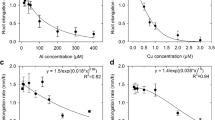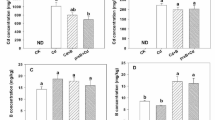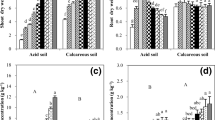Abstract
The effects of varying solution concentrations of manganese (Mn), zinc (Zn), copper (Cu), boron (B), iron (Fe), gallium (Ga) and lanthanum (La) on plant chemical concentrations, plant uptake and plant toxicity were determined in wheat (Triticum aestivum L.) grown in a low ionic strength (2.7×10−3 M solution culture). Increasing the solution concentration of Mn, Zn, Cu, B, Fe, Ga and La increased plant concentrations of that ion. Asymptotic maximum plant concentrations were reached for Zn (10 mg kg DM−1 in the roots), Ga (2 mg kg DM−1 in the tops and 18 mg kg DM−1 in the roots) and La (0.4 mg kg DM−1 in the tops and 4 mg kg DM−1 in the roots). Plant ion concentrations were, on average, 3 times higher in the roots than the tops for Mn and Zn, 7 times for Cu, 9 times for Fe, 12 times for Ga and 15 times for La. In contrast, B concentrations were higher in the tops than the roots by, on average, 2 times. The estimated toxicity threshold (plant concentration at which a rapid decrease in yield occurred) in the tops was 0.4 mg g DM−1 for B, 2 for Zn, 0.075 for Cu and 0.09 for La and in the roots 0.2 mg g DM−1 for B, 5 for Zn, 0.3 for Cu and 3 for La. Plant uptake rates of the ions (as estimated by the slope of the relationship between solution ion concentrations and plant ion concentrations) was in the order B<Fe<Mn<La<Zn<Ga<Cu for the tops and B<Mn<Fe<Zn<La<Cu<Ga for the roots. In the roots, the uptake rates of La, Cu and Ga was exceptionally high (> 250 mg kg DM−1 μM −1). Plant toxicity was estimated as the reciprocal of the plant concentration that reduced yield by 50% (change in relative yield per mg ion kg DM−1). The plant toxicity of the ions tested was in the order Mn<Zn<B<Fe=Ga<La<Cu in the tops and Mn<Ga<Zn<Fe=La<Cu<B in the roots. Copper was unusual in that plant uptake and plant toxicity was high for a plant trace nutrient.
Similar content being viewed by others
References
Bossan W D 1976 Nitrogen and phosphorus determination in animal feeds in a continuous flow system. Lab. Pract. 25, 763.
Burke D G, Watkins K and Scott B J 1990 Manganese toxicity effects on visible symptoms, yield and manganese levels, and organic acid levels in tolerant and sensitive wheat cultivars. Crop Sci. 30, 275–280.
Clarkson D T and Hanson J B 1980 The mineral nutrition of higher plants. Ann. Rev. Plant Physiol. 31, 239–298.
Clinton O E 1974 A curcumin method for boron compatible with an atomic adsorption system of plant analysis. N.Z. J. Sci. 17, 445–449.
Clinton O E 1979 Automation of flame spectroscopy for agricultural analysis. Chem. N.Z. 43, 143–145.
Cornforth I S and Sinclair A 1984 Fertiliser and lime recommendations for pastures and crops in New Zealand. (Second revised edition). New Zealand Ministry of Agriculture and Fisheries, Wellington, NZ.
Foy C D, Chaney R L and White M C 1978 The physiology of metal toxicity in plants. Ann. Rev. Plant Physiol. 29, 511–566.
Garrido M L 1964 Determination of sulphur in plant material. Analyst 89, 61–66.
Gehrke C W, Wall L L and Absheer J S 1972 Preliminary report on the Gehrke-Wal automated nitrogen method for feed Technicon International Congress 7, 25.
Jones J, Wolf B and Mills H A 1991 Plant Analysis Handbook. Micro-Macro Publishing, Athens, Georgia, USA.
Lindsay W L 1979 Chemical Equilibria in Soils. John Wiley, New York, USA.
Morad P 1986 Modelization of the relationship between copper contents and biomass production in Durum wheat. J. Plant Nutr. 9, 43–44.
Nable R O 1991 Distribution of boron within barley genotypes with differing susceptibilities to boron toxicity. J. Plant Nutr. 14, 453–461.
Reuter D J and Robinson J B 1986 Plant Analysis. An Interpretation Manual. Inkata Press, Melbourne, Australia.
Smith G S and Watkinson J H 1984 Selenium toxicity in perennial ryegrass and white clover. New Phytol. 97, 557–564.
Upsdell M P 1985 Bayesian inference for functions. PhD Thesis, Nottingham, UK.
Upsdell M P 1994 Bayesian smoothers as an extension of non-linear regression. N. Z. Statistician 29, 66–81.
Wallace A 1989 Plant responses to some hardly known trace elements and trace element composition and distribution in plants. Soil Sci. 147, 461–464.
Wheeler D M, Power I L and Edmeades D C 1993 Effect of various metal ions on growth of two wheat lines known to differ in aluminium tolerance. Plant and Soil 155/156, 489–492.
Author information
Authors and Affiliations
Rights and permissions
About this article
Cite this article
Wheeler, D.M., Power, I.L. Comparison of plant uptake and plant toxicity of various ions in wheat. Plant Soil 172, 167–173 (1995). https://doi.org/10.1007/BF00011318
Received:
Accepted:
Issue Date:
DOI: https://doi.org/10.1007/BF00011318




